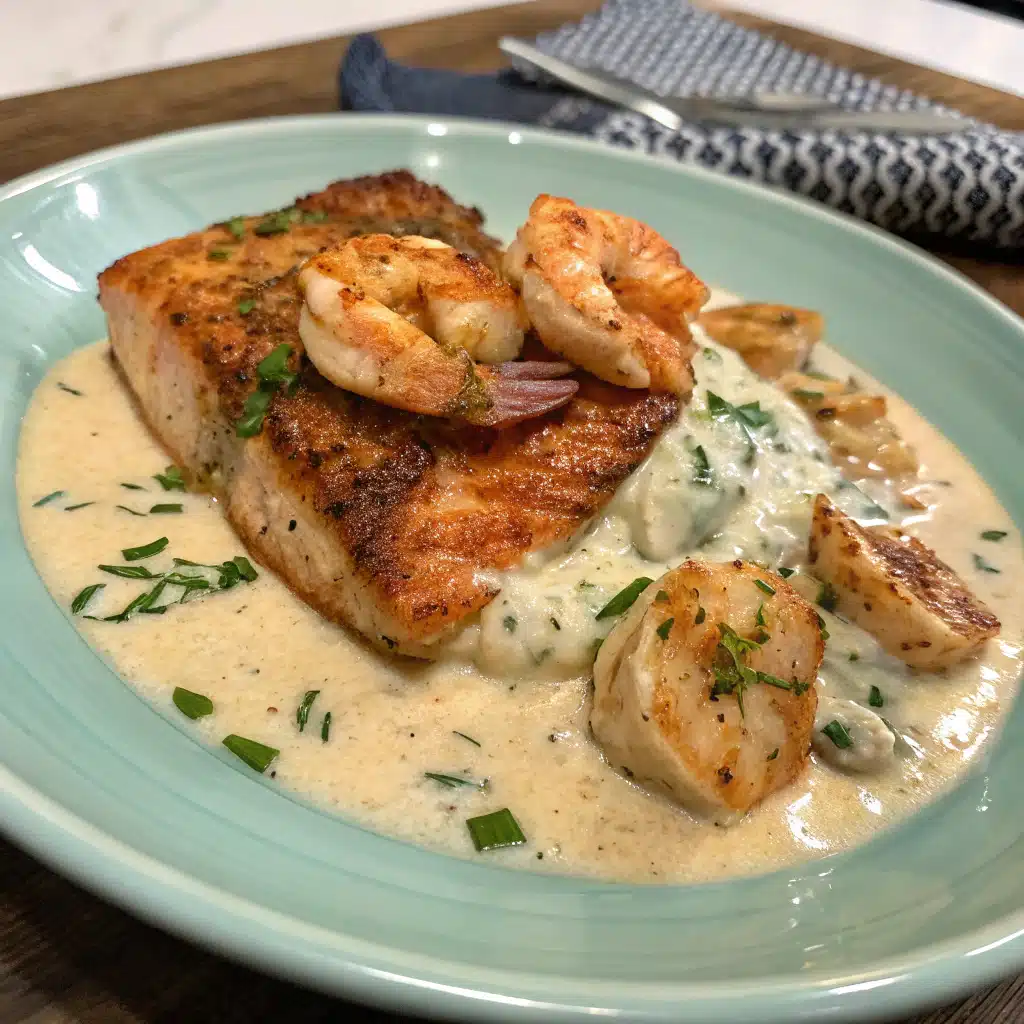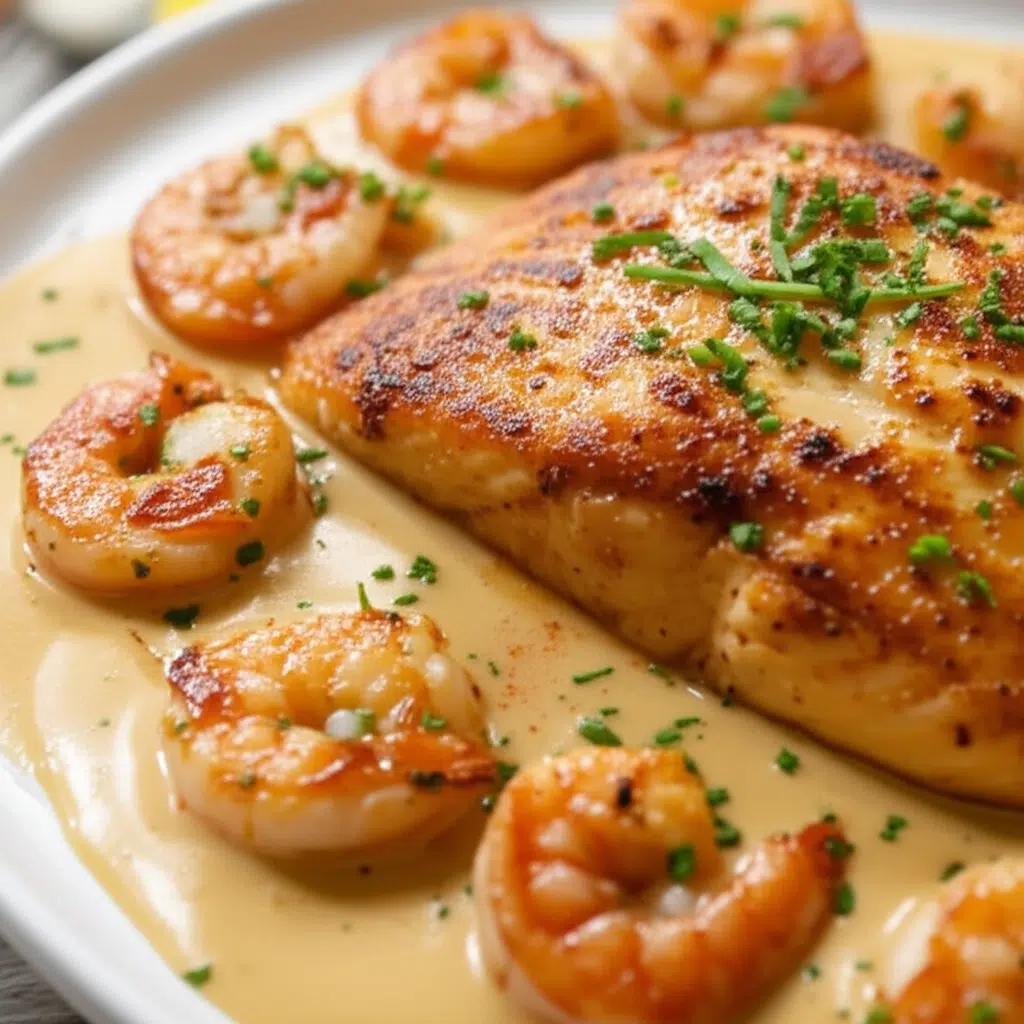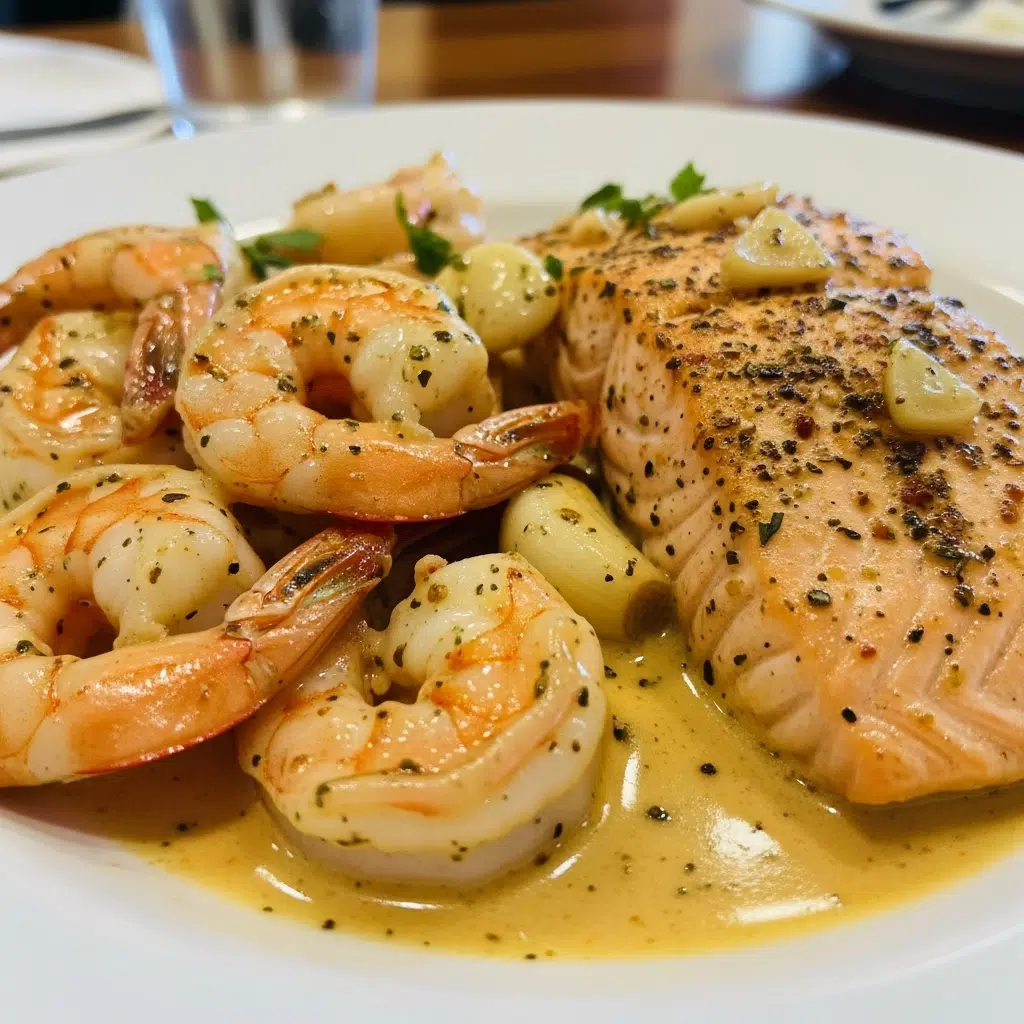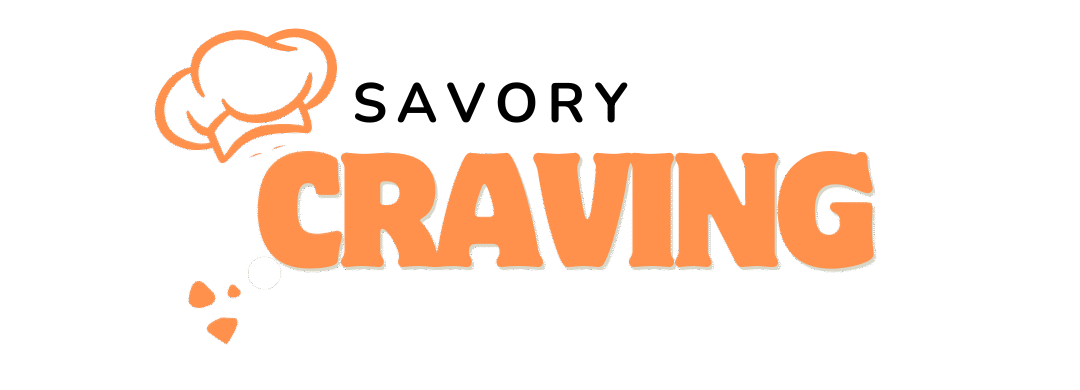Cajun Shrimp and Salmon with Garlic Cream Sauce is a quick, impressive dish that feels gourmet but comes together in no time. Perfect for dinner parties or a special weeknight meal, the spicy Cajun seasoning pairs beautifully with the rich, creamy garlic sauce. Your guests will think you’ve been cooking all day, even if you just whipped it up last minute.
Love More Seafood Recipes? Try My Baked Seafood Pasta or this Creamy Garlic Shrimp Over Mashed Potatoes next.

Why You’ll Love This Recipe
Tastes luxurious yet is surprisingly affordable, making it perfect for a special dinner any night of the week. Quick to prepare and packed with bold, savory flavors, it’s a crowd-pleaser that will impress family, friends, and even unexpected guests. Kids and adults alike will love it—leftovers disappear fast, and everyone will think you’ve been cooking all day.
Print
Cajun Shrimp and Salmon with Garlic Cream Sauce
- Total Time: 25 minutes
- Yield: 4 portions
Description
Perfectly seasoned salmon and shrimp in a rich, creamy garlic sauce with bold Cajun flavors. This elegant yet easy dinner is perfect for special occasions or when you want to treat yourself to something incredible.
Ingredients
Protein
-
- 4 salmon fillets (about 6 oz each) – get the thick ones if possible
-
- 20 large shrimp, peeled and deveined – I use 16/20 count
Seasoning
-
- 2–3 tablespoons Cajun seasoning – Old Bay works but Tony Chachere’s is better
-
- 1 teaspoon salt – kosher salt
-
- ½ teaspoon black pepper – fresh ground makes a difference
-
- Juice of ½ lemon – don’t use the bottled stuff
Sauce Base
-
- 2 tablespoons butter – real butter, not the fake stuff
-
- 4–5 garlic cloves, minced – more if you’re like me and love garlic
Liquids
-
- 1 cup heavy cream – splurge on the good stuff
Instructions
Pat the seafood completely dry, then generously coat it with your seasoning mix—bold flavors are key. Let it rest about ten minutes so the salt starts breaking down the proteins, which helps with browning.
Heat a pan until very hot, then sear the salmon without touching for about 4 minutes until it releases easily. Flip and cook 2–3 more minutes, then remove—leave the browned bits for extra flavor.
In the same hot pan, cook shrimp about 90 seconds per side until they form a loose “C” shape, then remove with the salmon. Keep the browned bits in the pan—they’re the base for your sauce.
Lower the heat to medium, melt butter, and sauté garlic briefly until fragrant. Stir in cream and simmer gently for 3–4 minutes until it thickly coats a spoon, letting the browned bits infuse flavor.
Return the salmon and shrimp to the sauce, spooning it over them, and heat for about three minutes so the seafood finishes cooking. Taste and adjust with lemon or salt as needed.
Plate everything and be generous with that sauce. I use a big spoon to make sure I get all the good bits onto each plate. Serve right away while everything’s hot and the sauce is silky.
Notes
Dry your seafood obsessively. Seriously. I cannot overstate this. Wet seafood steams instead of sears and you lose all that flavor and texture.
Don’t flip the salmon until it releases easily. If you try to force it and it’s sticking, wait another minute. Patience pays off with perfect golden crust.
Keep the heat at medium for the sauce. I know you’re hungry but high heat will curdle the cream and make it grainy. Low and slow wins.
Shrimp cook incredibly fast. I set a timer for ninety seconds per side because I get distracted easily. Overcooked shrimp are bouncy and gross.
Season generously but taste as you go. Some Cajun seasonings are saltier than others. I learned to adjust after making it too salty for my kids several times.
Buy good ingredients. The cream makes a huge difference – don’t go cheap. Same with the seafood. Fresh is obviously best but good frozen works fine if thawed properly.
The biggest mistake everyone makes is overcooking. The seafood continues cooking in the sauce so stop before you think it’s done. Better slightly underdone than leather.
- Prep Time: 10 minutes
- Cook Time: 15 minutes
- Category: Main Dish
- Method: Pan-seared
- Cuisine: American
Ingredient List
Protein
- 4 salmon fillets (about 6 oz each) – get the thick ones if possible
- 20 large shrimp, peeled and deveined – I use 16/20 count
Seasoning
- 2-3 tablespoons Cajun seasoning – Old Bay works but Tony Chachere’s is better
- 1 teaspoon salt – kosher salt
- ½ teaspoon black pepper – fresh ground makes a difference
- Juice of ½ lemon – don’t use the bottled stuff
Sauce Base
- 2 tablespoons butter – real butter, not the fake stuff
- 4-5 garlic cloves, minced – more if you’re like me and love garlic
Liquids
- 1 cup heavy cream – splurge on the good stuff
Why These Ingredients Work
Cajun seasoning is magic on seafood but here’s the thing – not all blends are created equal. I’ve tried probably eight different brands and Tony Chachere’s wins every time. It’s got this perfect balance where you get flavor without your mouth being on fire.
Salmon fillets need to be thick enough to not overcook. Those thin tail pieces from the grocery store will turn to mush. I ask the fish guy for center-cut fillets and it’s worth the extra two dollars. The natural oils in salmon work so well with spicy seasonings – learned that from my dad who used to grill salmon with blackening spice every summer.
Large shrimp are crucial here. I tried this with medium shrimp once and they disappeared into the sauce. You want shrimp that hold their own against that rich salmon. Plus bigger shrimp don’t overcook as fast, which happens to me more than I’d like to admit.
The cream sauce is where I get fancy. My sister-in-law Lisa taught me to brown the garlic in butter first. It gets sweet and nutty instead of harsh. Then when you add cream to a hot pan with all those browned bits from the seafood, it becomes this incredible sauce that costs fifty dollars at restaurants.
Fresh lemon juice at the end cuts through all that richness. Sometimes I add lemon zest too when I remember to zest before juicing. My brain doesn’t work that way usually.
Essential Tools and Equipment
My cast iron skillet is everything for this dish. It gets blazing hot, holds heat perfectly, and gives the best sear. I inherited mine from my grandmother and it’s seasoned better than anything you can buy new. If you don’t have cast iron, use the heaviest pan you own.
Paper towels are crucial – I go through half a roll drying seafood. Wet fish equals steamed fish equals disappointed dinner guests. I learned this lesson the hard way during my first attempt at cooking salmon for my in-laws.
I use a microplane grater for garlic because mincing with a knife takes forever and I’m usually rushing. Plus the microplane makes the garlic almost paste-like which dissolves better into the sauce.
Tongs for flipping salmon safely. I’ve broken too many fillets trying to use a spatula. Tongs give you control and keep the fish in one piece.
How To Make Cajun Shrimp and Salmon with Garlic Cream Sauce
Season the seafood
Pat the seafood completely dry, then generously coat it with your seasoning mix—bold flavors are key. Let it rest about ten minutes so the salt starts breaking down the proteins, which helps with browning.
Cook the salmon
Heat a pan until very hot, then sear the salmon without touching for about 4 minutes until it releases easily. Flip and cook 2–3 more minutes, then remove—leave the browned bits for extra flavor.
Cook the shrimp
In the same hot pan, cook shrimp about 90 seconds per side until they form a loose “C” shape, then remove with the salmon. Keep the browned bits in the pan—they’re the base for your sauce.
Make the garlic cream sauce
Lower the heat to medium, melt butter, and sauté garlic briefly until fragrant. Stir in cream and simmer gently for 3–4 minutes until it thickly coats a spoon, letting the browned bits infuse flavor.
Combine everything
Return the salmon and shrimp to the sauce, spooning it over them, and heat for about three minutes so the seafood finishes cooking. Taste and adjust with lemon or salt as needed.
Serve immediately
Plate everything and be generous with that sauce. I use a big spoon to make sure I get all the good bits onto each plate. Serve right away while everything’s hot and the sauce is silky.

You Must Know
I keep the salmon slightly underdone during the first sear. It finishes perfectly in the sauce and never gets dry or tough. Took me probably ten attempts to figure out the right timing.
Personal Secret: Never wash the pan between steps. Those browned bits from the salmon and shrimp make the sauce a thousand times better. It’s the difference between good and restaurant-quality.
Pro Tips & Cooking Hacks
Dry your seafood obsessively. Seriously. I cannot overstate this. Wet seafood steams instead of sears and you lose all that flavor and texture.
Don’t flip the salmon until it releases easily. If you try to force it and it’s sticking, wait another minute. Patience pays off with perfect golden crust.
Keep the heat at medium for the sauce. I know you’re hungry but high heat will curdle the cream and make it grainy. Low and slow wins.
Shrimp cook incredibly fast. I set a timer for ninety seconds per side because I get distracted easily. Overcooked shrimp are bouncy and gross.
Season generously but taste as you go. Some Cajun seasonings are saltier than others. I learned to adjust after making it too salty for my kids several times.
Buy good ingredients. The cream makes a huge difference – don’t go cheap. Same with the seafood. Fresh is obviously best but good frozen works fine if thawed properly.
The biggest mistake everyone makes is overcooking. The seafood continues cooking in the sauce so stop before you think it’s done. Better slightly underdone than leather.
Common Mistakes to Avoid
I’ve screwed this up plenty of times, so learn from my disasters:
Don’t cook the seafood completely the first time. It finishes in the sauce and overcooking makes it tough and disappointing.
Don’t make the sauce on high heat. I’ve curdled the cream more times than I want to admit because I was impatient. Medium heat, gentle simmer.
Don’t overcrowd the pan. If your skillet isn’t big enough for all the seafood, cook in batches. Crowded pans create steam not sear.
Don’t use jarred minced garlic. Fresh garlic becomes sweet and nutty when sautéed properly. Jarred garlic just tastes sharp and weird.
Don’t skip patting the seafood dry. This is probably the most important step for getting good flavor and texture.
Flavor Variations & Suggestions
I add white wine sometimes – maybe a quarter cup before the cream. It adds depth and makes me feel fancy. Let it cook off for a minute before adding cream.
Fresh herbs are amazing here. Thyme from my garden works great, or parsley at the end for color. My neighbor gives me herbs from her garden and they make everything taste more expensive.
For extra heat, I add red pepper flakes to the cream or use spicier Cajun seasoning. My husband likes it hot but I keep it mild for the kids usually.
A squeeze of fresh lemon at the very end brightens everything up. Sometimes I add lemon zest if I remember to zest before juicing, which happens maybe half the time.
I’ve made this with scallops instead of shrimp and it’s incredible. More expensive but worth it for special occasions. Same cooking method.
Make-Ahead Options
I season the seafood in the morning and keep it covered in the fridge. The flavors penetrate better with time and it actually tastes more seasoned.
You can prep all the sauce ingredients ahead too. Mince the garlic, measure the cream, have everything ready to go. This recipe moves fast once you start cooking.
Leftover sauce keeps in the fridge for a couple days and reheats well. I’ve used it on pasta, chicken, whatever needs sauce.
The whole dish can be made ahead and reheated gently but it’s definitely best fresh. If reheating, use low heat and maybe add a splash more cream.
Recipe Notes & Baker’s Tips
Perfect salmon flakes easily but still looks slightly pink in the center. If you’re paranoid about doneness, use a thermometer – 145°F is the target.
Large shrimp are worth the extra cost. They don’t overcook as easily and have better texture. I buy the 16/20 count which means 16-20 shrimp per pound.
Let your pan get screaming hot before adding salmon. You want to hear aggressive sizzling when it hits the pan. That sound means proper browning is happening.
Room temperature cream incorporates better than cold cream straight from the fridge. I take it out while I prep everything else.
If your sauce seems thin, don’t panic. It thickens as it cools and the starch from rice or potatoes helps thicken it on the plate.
Serving Suggestions
Mashed potatoes underneath are perfect for soaking up sauce. I make basic mashed potatoes with butter and milk – nothing fancy needed since the sauce is the star.
Rice works great too. White rice, brown rice, even cauliflower rice when I’m pretending to eat healthy. The sauce coats everything beautifully.
Crusty bread is essential for sauce-mopping. I buy good bakery bread and warm it in the oven. My family fights over who gets to soak up the last drops of sauce.
Simple vegetables on the side – roasted asparagus, steamed broccoli, green beans. Nothing too fancy since the main dish is rich and flavorful.

How to Store Your Cajun Shrimp and Salmon
Leftovers last maybe two days in the fridge in a covered container. The sauce thickens up which is totally normal.
To reheat, I use a skillet on low heat and add a splash of cream to loosen the sauce. Stir gently until warmed through. Don’t blast it on high heat or the seafood gets tough.
Microwave works if you’re careful – 50% power in thirty-second intervals, stirring between. Otherwise you get hot spots that overcook the seafood.
I don’t freeze this. The cream sauce gets weird when frozen and thawed, and seafood texture suffers. Better to eat fresh or within a day or two.
Sometimes I store the seafood and sauce separately and reheat them together. Gives more control over the final texture.
Allergy Information
This has several allergens you should know about:
Contains: Fish, shellfish, dairy
For dairy-free, coconut cream works instead of heavy cream. Different flavor but still good – more tropical tasting. Use olive oil instead of butter.
Everything’s naturally gluten-free if your Cajun seasoning is gluten-free. Most are but check the label to be sure.
For shellfish allergies, just use salmon – about a pound and a half total. Or substitute scallops if those are okay.
Questions I Get Asked A Lot
Q: Can I use frozen seafood? A: Yeah, just thaw completely and pat extra dry. Frozen seafood releases more water so the drying step is even more important.
Q: My sauce separated – what happened? A: Too much heat usually. Keep it at medium and be patient. If it breaks, sometimes whisking in cold cream off the heat fixes it.
Q: Just shrimp or just salmon? A: Absolutely. Use about one and a half pounds of whatever you prefer. Timing might be slightly different.
Q: How spicy is this really? A: Mild to medium heat. My kids eat it happily but they’re used to spicy food. Start with less seasoning if you’re worried.
Q: No Cajun seasoning available? A: Make your own – paprika, garlic powder, onion powder, oregano, thyme, cayenne, salt, pepper. I keep homemade blend in a jar.
Q: Can I use half-and-half instead of heavy cream? A: The sauce won’t be as rich or thick but it works. Might need to simmer longer to get good consistency.
Q: Why does my salmon stick? A: Pan isn’t hot enough or salmon isn’t dry enough. Make sure your pan is properly heated and seafood is completely dry.
Q: Can I add vegetables? A: I keep vegetables as sides to avoid overcrowding but you could sauté peppers or onions first and add back with the sauce.
💬 Made this recipe? Tell me how it went! Did you change anything? What did you serve with it? I love hearing about your cooking adventures.

